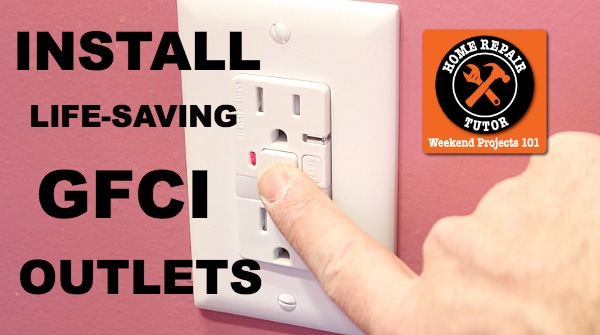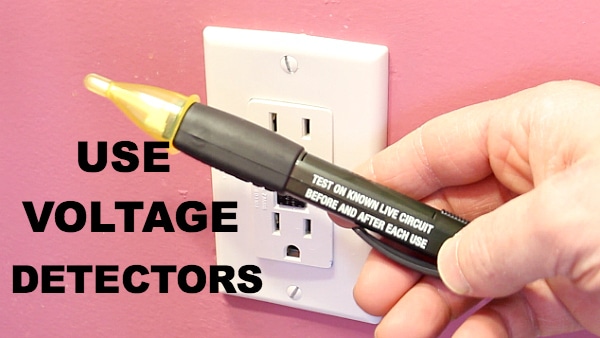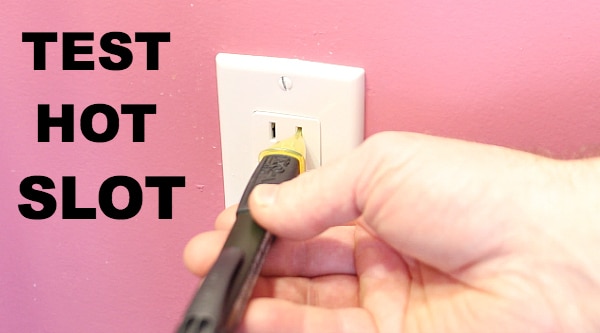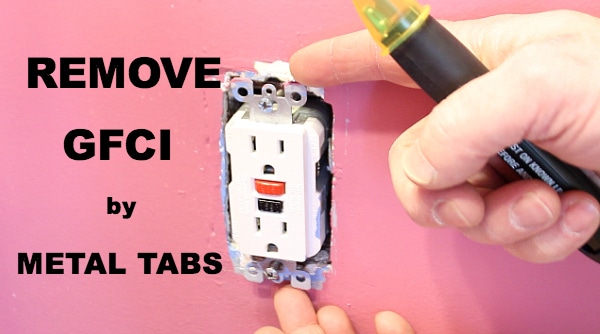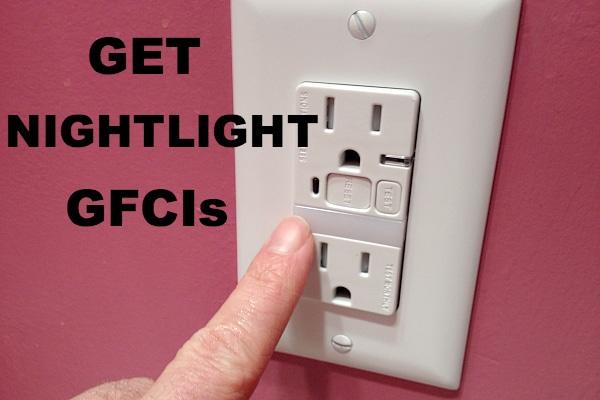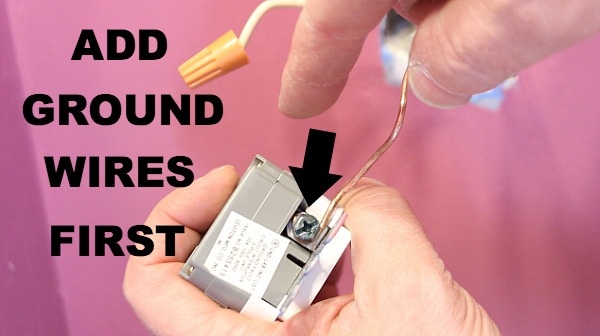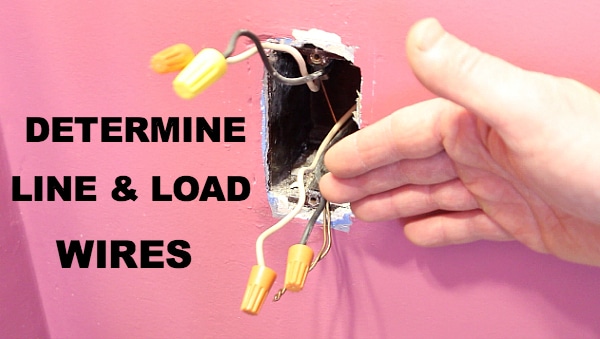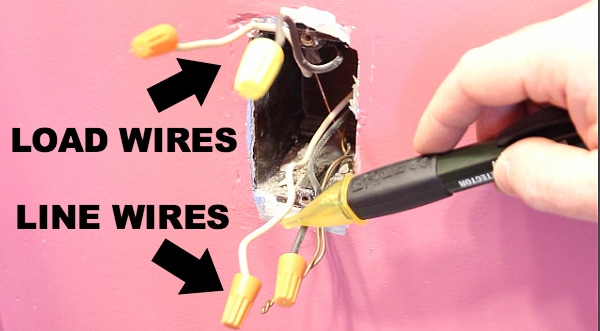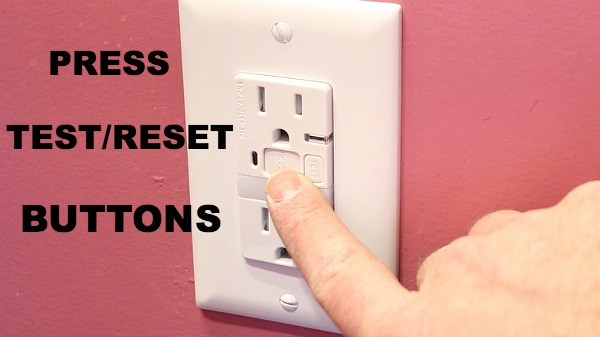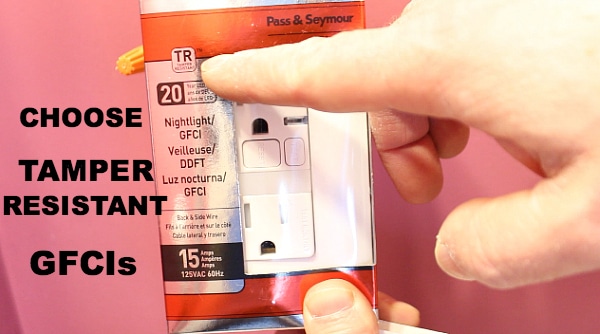I got shocked.
It was over 10 years ago but I still remember the jolting feeling.
If you’ve seen Back to the Future you probably know how Doc Brown got his white hair.
Well, I felt how he looked.
Why is this so dangerous? It’s simple: the human heart has electrical impulses and that rhythm, if interrupted, can be deadly – especially for children.
Certain rooms in your house are required to have GFCI outlets so that you won’t be shocked.
Knowing where they need to be and how to install them can save you a ton of dough. And allow you to sleep a lot better at night.
GFCI Installation Supply List
GFCIs are required by electrical code (I’m talking about the states here) in bathrooms, kitchens, outdoor spaces, and garages.
These are places where moisture creates electrical hazards and you need protection.
Why all this hubbub over an outlet?
Here’s the deal, GFCI’s detect even the tiniest leak in electrical current, and they immediately shut off the power. Simply put: they protect your butt from being electrocuted.
Learning how to wire this kind of outlet is easy and I’ll show you how to do it in 30 to 60 minutes. Plus, you’ll get a ton of great tips that will impress your friends.
Here’s the supply list:
- Phillips Head Screwdriver
- Combination Strippers ($10)
- Lineman’s Pliers ($16)
- Voltage Detector ($16)
- 15 Amp GFCI Outlet – Slim Fit and Tamper Resistant ($17.86)
- GFCI Remodel Electrical Box – PVC and 20 Cubic Inches ($1.96)
- Wire Nuts ($3)
GFCI Installation Checklist
Here’s what you’ll learn:
- How to use a voltage detector to safely unwire an outlet
- How to wire a GFCI with one set of wires in an electrical box (green/bare copper, white, and black)
- How to wire a GFCI with two sets of wires in an electrical box (green/bare copper, white, and black) and protect downstream outlets from electrical leaks
- How to properly strip copper wires based on the device you’re using
- How to pick the correct kind of electrical box for a GFCI
- How to test a GFCI to see if it’s working
Buying a new GFCI could be the best $17.86 you’ll ever spend because it’ll keep you safe while blow-drying your hair.
Although most of the time I seem to be doing more flat ironing, yes I know how to flat iron hair. It’s a long story. Ask in the comments.
But first, I’d like to take the mystery out of the GFCI wiring process and start with a quick lesson on detecting electricity.
(OKAY, here’s my DISCLAIMER: electrical work is dangerous. Using hand or power tools improperly or ignoring safety precautions can lead to permanent injury or death. Please don’t try to perform any projects you learn here unless you’re certain they’re safe for you. If you’re unsure of something, PLEASE DON’T DO IT. Call a licensed professional. I want you to enjoy DIYing , so keep safety at the top of your priority list!!)
Testing GFCI Power
Voltage detectors are a must-have for any DIYer.
$16 is way cheaper than a trip to the emergency room. Go to your local home store and buy one.
You’ll love voltage detectors if you’re doing any kind of electrical work because the plastic tip will glow (or chirp) when it’s brought into contact with anything that’s energized with electricity.
Place the tip of the voltage detector near an outlet screw terminal, slot, or wire. And if it glows then you know power is still flowing to the outlet.
Always hold the tester so that the insulated portion is in your hand. This ensures electricity won’t flow toward you when testing devices.
Test your old outlet or GFCI with the voltage detector before turning off the power to it. Place the tip of the detector in the outlet’s hot slot.
Safely Removing Old GFCI Outlet
Once you confirm there’s power running to the outlet go to your electrical panel and turn off the circuit breaker that supplies electricity to the outlet.
Then double-check the outlet has no power by using your voltage detector.
Place it in the hot slot again. Then test the neutral and ground slots to make sure the outlet wasn’t wired incorrectly, i.e. someone wired the hot wire to the outlet’s neutral terminal screw.
Believe me, I’ve seen this before!!! It’s pretty easy to forget to wire the black wire to the brass terminal.
Now you can remove the outlet’s cover plate by unscrewing the screws counterclockwise with a screwdriver.
Pull the outlet out from the electrical box by touching the metal tabs on the top.
DON’T touch the sides of the outlet or the terminal screws!!! Whew, I’m glad you read this. Test the black and white wires with your voltage detector.
If the tip doesn’t glow then it’s okay to unscrew the terminals and remove the wires. But do it in this order:
- Black first
- White second
- Ground last
Installing New GFCI Outlet
Sweet, now you can move on to installing a brand spanking new GFCI.
I decided to get one with an LED nightlight in it. Primarily because I’m getting older and need to use the bathroom at least once during the night.
Everyone in my family has small bladders.
How to Wire GFCI Outlets
There are two different wire terminals on a GFCI: Line and Load.
You need to know what these terms mean in order to properly wire this kind of outlet.
Wires that go into the Line terminals are coming from a power source, for example, your circuit breaker.
These are the wires that supply electricity to the GFCI.
Wires that leave the GFCI and provide electricity to another outlet are secured to the Load terminals.
These wires are going to outlets downstream so to speak.
If you only have one set of wires (green/bare copper, white, and black) you’re wiring is easy. Connect the green/bare copper (ground wire) to the green terminal and the black & white wires to the Line terminals.
Make sure the white (neutral wire) goes with the silver terminal screw and the black (hot wire) is partnered with the gold terminal screw. Wire the ground wire first, neutral wire second, and hot wire last.
This configuration means that your GFCI is only protecting itself, i.e. it will be the only outlet that shuts off if there is an electrical leak.
Line Versus Load Wires for GFCIs
If you have two sets of wires (two black, two white, and two green/bare copper) you’ll have to take one extra step versus the above process.
But this is no sweat – it’s easier than changing a toilet paper roll.
The hardest part is determining which set of wires are Line wires. Remember, these are the wires that provide electricity to the GFCI.
Usually, but now always, the Line wires will be the ones on the bottom of the electrical box.
There are two ways to test for the Line wires. You could pull each set of hot (black) and neutral (white) wires from the electrical box.
Make sure they’re sticking out as far as they can go from the box and aren’t touching. Then add wire nuts to the bare copper on all the hot and neutral wires.
Turn the electricity back on at the panel. Then touch your voltage detector to each hot (black) wire. Whichever wire is energized will indicate your Line wires.
The second set of wires will then be your Load wires.
A second, and safer way to test for the Line wires is to attach one set of wires to your GFCI’s Line terminals. You’ll want to attach the bare copper/green wire to the green terminal. Then add the neutral (white) to the silver Line terminal and the hot (black) to the brass Line terminal.
This method will require the second set of wires to be capped with wire nuts: the neutral (white) wire will have a wire nut capping it and the hot (black) wire will have its own nut as well.
Again, you’ll want to turn on the power to the outlet at the panel. If electricity is flowing to the GFCI that means the wires attached to it are the Line wires and the capped wires are the Load wires.
If you don’t have electricity flowing to the GFCI you’ve attached the Load wires to the Line terminals. This isn’t unsafe. You’ll just have to relocate the Load wires to the Load terminals.
Check out my video for the rest of the details on how to install a GFCI. I’ll walk you step-by-step through the wiring process and you’ll see that is pretty darn easy.
Testing Your Wiring: Did You Do It Right?
Before adding the GFCI faceplate you need to test your wiring.
Fortunately, GFCI’s have Reset and Test buttons that help with this process.
With the GFCI screwed to the electrical box and the power turned on at the panel you can press the Reset button.
It should stay pressed into the GFCI. If it doesn’t you’ll need to check the wiring for mistakes or loose connections or wires touching a metal box.
If your Reset button does stay pressed in the GFCI you should press the Test button with a light plugged into it to double-check the electricity flow. Hitting the Test button should turn off the light.
You’ll have to press the Reset button a second time to make the GFCI energized.
One more thing about GFCIs. They will protect all outlets downstream if they have Load wires attached to Load terminals. This means that if the GFCI trips (the Reset button pops out) the outlets downstream won’t have electricity running to them.
So, you should check for a tripped GFCI if you have an outlet that’s stopped working. And you’ll need to figure out why the GFCI tripped. It could indicate that there’s a short in the outlet that stopped working.
Regardless, it’s a good thing GFCIs were invented – they make modern living a whole lot safer. Don’t forget to test your GFCIs once a month by pressing the Test/Reset buttons.
Follow the specific directions that come with your GFCI and choose one that suits your style or needs.
Choosing GFCI Outlets
Choose a GFCI that is tamper-resistant since the code mandates all outlets be safe for children. Tamper-resistant outlets have slots that are spring-loaded and only work when both the hot & neutral are plugged into at the same time. This prevents any kid who tries to stick a paperclip into the hot slot from being electrocuted.
And lately, I’ve been really liking the outlets that have the nightlights. This is great for kids or grownups who require a potty break in the middle of the night!!
LED lights will last for almost 20 years and won’t cause your electrical bill to go up.
As a summary, this is what you should have learned today:
- How to use a voltage detector to safely unwire an outlet
- How to wire a GFCI with one set of wires in an electrical box (green/bare copper, white, and black)
- How to wire a GFCI with two sets of wires in an electrical box (green/bare copper, white, and black) and protect downstream outlets from electrical leaks
- How to properly strip copper wires based on the device you’re using
- How to pick the correct kind of electrical box for a GFCI
- How to test a GFCI to see if it’s working
- Get a GFCI that is tamper-resistant and possibly has an LED nightlight
What’s Next
GFCI outlets are also required outside – our tutorial has great tips for installing one for holiday lights or anything else.
If you’re doing a bathroom remodel and need help, join one of our online courses – they’ll make your bathroom renovation much easier!
Let me know if you have any questions and I’ll do my best to help.
Thanks as always for reading, watching, and being part of our awesome community.
Cheers,
Jeff



